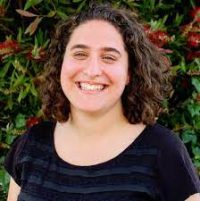By Naomi Zipursky
June 22, 2021

The moment I saw JIMENA’s announcement about their first Sephardic Leaders Fellowship, I knew I would do whatever necessary to be part of this learning cohort. I’m an Ashkenazi Jew, who was born and raised in Omaha, went to university in Atlanta, and moved to San Francisco about 4 years ago – not exactly who you’d think you’d find in a Sephardic Leaders Fellowship. I name all of this because in all my years involved in the Jewish world, this is my first experience fully immersing myself in Sephardic, Mizrahi, and Israeli education and culture – WHAT?! How has it taken this long to get here? To me, this illustrates the deep and urgent need for Jewish communities and institutions to fully embrace, promote, and include Sephardic, Mizrahi, and Israeli Jews within our spaces. And it’s on folks like me to do the heavy lifting in making this happen.
Here’s where I propose we start:
- Stop to reflect, but don’t stop there! In one of our very first fellowship meetings, I heard my cohort members share about the ways in which they felt both unseen and couldn’t see themselves reflected in their Jewish communities. Upon hearing this, I felt so many things at once – a heavy sadness in my heart, deep anger and disappointment in my Jewish community, and a sense of guilt. How have I, as a white, Ashkenazi Jew, perpetuated this within the Jewish community? It’s not an easy question to reckon with, and while I still find myself reflecting on this every day, I’ve kept moving forward. For the past few years, my team at San Francisco Hillel and I make a point of serving Sephardic jeweled rice alongside tzimmes at Erev Rosh Hashanah and strive to facilitate panels that always include Sephardic, Mizrahi, and Israeli voices. These are only two small examples that keep us pushing forward. Inclusion work doesn’t happen overnight; it’s life work. And, until we have more representation in our leadership spaces, it’s incumbent on the existing leaders to make an effort. And to my fellow Ashkenazi leaders – take the time to deeply reflect, but don’t stop there. I believe we all have the strength and obligation to leverage our positional power to amplify understanding and inclusion. Take the time to listen, ask questions, and learn. And then keep moving toward our ultimate goal of embracing those who have felt most erased in our communities.
- In order to amplify voices from within our community, they must already be in the room. This feels somewhat obvious, but how many of us reading this have sat through lectures, panels, and events speaking about Sephardic and Mizrahi experiences without a single Sephardic or Mizrahi voice leading the conversation? This is unacceptable and must change if we ever want our Sephardic, Mizrahi, and Israeli friends to actually see themselves within our institutions and communities. Next time you host an event discussing Sephardic Jewish in America, invite Dr. Mijal Bitton. When hosting a seminar on DEI (Diversity, Equity & Inclusion) practices in the Jewish community, invite Rabbi Daniel Bouskila to facilitate a text study on the ancient Sephardic practices of DEI. And, when hosting a panel on antisemitism today, ensure Dr. Sharon Nazarian is a featured panelist. As we uplift Sephardic, Mizrahi, and Israeli voices within our spaces, we get closer to ensuring every voice is heard.
- Let’s celebrate more than food and music. Yes, shakshuka is my ultimate comfort food and yes, A-WA is my favorite Israeli band, AND, my celebration of Sephardic, Mizrahi, and Israeli culture cannot stop there. To fully embrace Sephardic, Mizrahi, and Israeli Jews in our Jewish institutions and communities, we must do so authentically and holistically. How are we utilizing resources like HeHaCham Hayomi (The Daily Sage) to ensure our text studies are diverse and representative of sages from across the Jewish world? When we teach our students, friends, and community members about Jewish life cycle events, are we incorporating lessons on la fijola or las fadas, the Sephardic baby naming ceremony where the newborn’s family gathers to sing songs, wish her blessings, and announce the baby’s name? What about when we teach about Passover – are we ensuring Mimouna is as essential in our lesson plans as the 10 Plagues? And when are we creating a petition for Duolingo to add Ladino to the languages you can learn on their app? When we incorporate the full richness of Sephardic, Mizrahi, and Israeli Jewish culture, history, language, and customs, we will see a true sense of belonging.
I am beyond grateful for this opportunity to have learned with and from an incredible cohort of Sephardic, Mizrahi, and Israeli educators and leaders, and for organizations like JIMENA that do the hard work of amplifying and uplifting our community every day. You all inspire me to be a better Jewish professional and community member. May we soon see the day when our friends, family members, and loved ones no longer feel erased by their Jewish community but instead, fully embraced.